Wildlife Photography by marysejansenart
Slow down and discover these little wonders of nature!
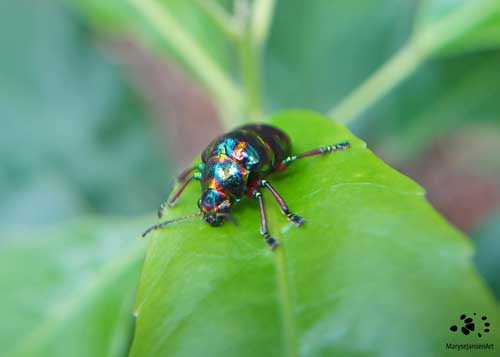
Taking it slow when you walk in nature opens your eyes to detail. On my recent walk in the rainforest I was initially just enjoying the beautiful scenery of lush vegetation. When I stopped for a moment to inspect a little colourful speck on one of the plants, I found a beautiful Leaf Beetle! I slowed down and found a myriad of interesting little critters that I easily would have overlooked if I had just been walking at a regular pace… and a number of these are also Leaf Beetles.
Table of Contents
Why do Leaf Beetles have such beautiful colours?

The little insect is bright orange-red and features a shiny metallic blue shield. It is quite a stunning combination of colours that really stands out in this predominantly green environment, like natural jewelry on the shrub! Certainly bright enough to attract my attention! It is commonly assumed that these bright colours in these and other Leaf Beetles serve to deter predators. However, this idea has been challenged!
Research has shown that these bright colours serve as camouflage rather then a warning signal! It was found that the colours are similar to the host plants that the beetles live on. However, when a species feeds on multiple plants, it has to compromise its level of camouflage. Other factors that influence their colouring are how light their environment is and how large they are.
They can defend themselves against predators by secreting toxins, which they have taken in from their host plants. Most commonly, you will find Leaf Beetles on Eucalyptus and Acacia. They are largely preyed upon by birds, but also spiders and carnivorous insects.
Getting close up with some bedazzling Leaf Beetle species
An estimated 3000 species of Leaf Beetles (family Chrysomelidae) inhabit Australia!!

The beautiful beetle that I am looking at here is called an Orange-blue Narrow-necked Leaf Beetle! A mouthful, but a very descriptive name. It belongs to the subfamily Criocerinae.
As I have stopped to inspect this creature I notice there is more to discover. I spot another Leaf Beetle. This one is a light golden brown in colour, it’s very pretty! It is a Eucalyptus Leaf Beetle.
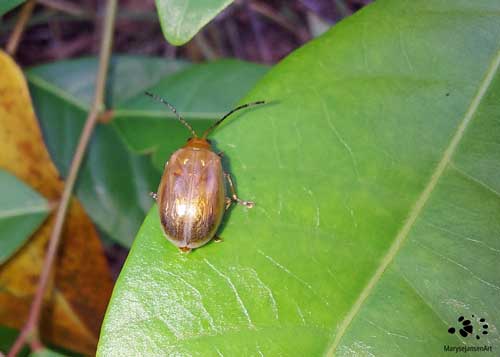
And there is yet another one! What an beauty! This one has a spectacular pattern of various metallic colours, I instantly nickname it Rainbow Beetle!! You can admire it in the featured image as well as in the image below.

Are you yet bedazzled by this bejewelled creature?
Interestingly, I struggle to find out which species it is. It’s safe to say that it’s a Leaf Beetle and that it’s metallic and I scroll and scroll through numerous images of all sorts of beetles, but I can’t find it! I consult a zoologist and he reckons it is possibly of the genus Callidemum, also known by the common name of Metallic Green Leaf Beetles. I search on this genus and I can see the similarity with his suggestion, the Callidemum tibialis, of which I find a handful of photos.
There is practically no information on these beetles which I think is quite surprising, considering their visual attractiveness! So as far as identification goes, this is the best I can offer. Despite that, I think the main thing is that we can admire its beauty!
Beetle Anatomy and Life Cycle
Leaf Beetles have two pairs of wings: one membranous pair for flying, and a second pair for protection. The protective wings are hardened and cover the flying wings like a shield when the beetle is not flying. These hardened wings are called elytra. This enables them to live in a great variety of environments where other winged-creatures would damage their wings, including soil and leaf litter.

Beetles lay eggs and the larvae that hatch from the eggs are called grubs, they can sometimes be mistaken for little caterpillars. In most species the grubs feed underground, on leaf litter or inside trees, but in some species the grubs feed on green leaves. Adult beetles generally feed on green leaves and flowers. Check out the beautiful White Acacia Leaf Beetle Grub which I have spotted in my own backyard on an Acacia I had planted.
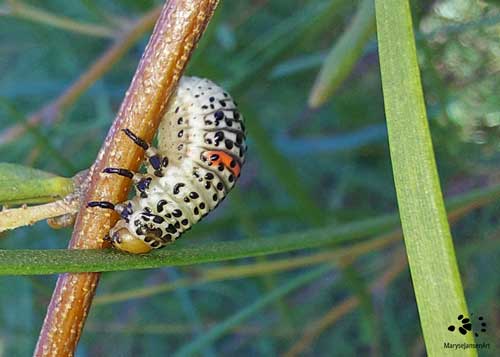
Like caterpillars, the grubs pupate before they emerge as an adult insect. The adult White Acacia Leaf Beetle (Dicranosterna circe) has very stylish looks. It is creamy white to pale green and has a dark brown ‘beauty spot’ on each wing cover! Check out this mating pair that I once photographed for my Nature-bites Project!
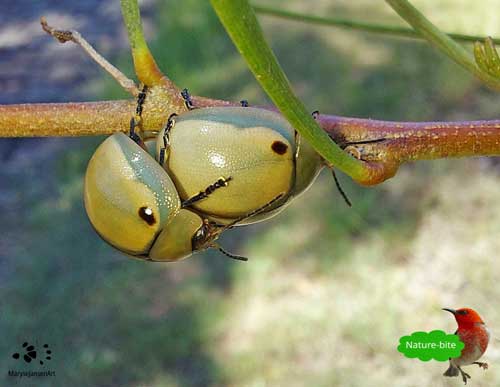
Summer is the best season to spot Leaf Beetles
Summer is such a good time to spot Leaf Beetles! On another walk I spot some other species. I have just introduced you to one of them. The other one is closely related, this is the Acacia Leaf Beetle (Dicranosterna immaculata). It is ever so slightly larger then the White Acacia Leaf Beetle, has a similar shape and is dark red in colour with large black blotches covering the hard wings.
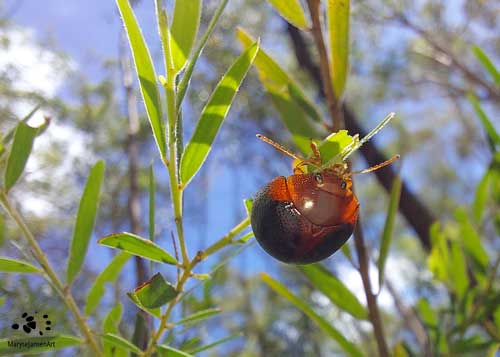
When you come too close: the beetles tend to go in hiding on the underside of the leaf that they are on. Probably a great strategy to avoid bird predation! This one seems pretty undisturbed though as it keeps munching away at the leaf!
Join me on my walk in latest episode of ‘Come for a walk in the Australian Bush’ and spot some of these beautiful beetles in the rainforest.
If you follow my YouTube Channel, you may have seen a few other beetles that feature in this post in my walk last week too, but if you’ve missed it, you can check it out here. You will spot some amazing other wildlife as well!
If you enjoy looking for detail, check out my post ‘Discover the wonders of the Undergrowth‘!


